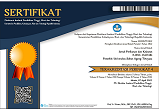Mangrove Ecosystem Resource Management Based on Silvofishery (The Case of RPH Tegal - Tangkil, KPH Purwakarta, Blanakan Subang East Java)
Abstract
widely known and practiced, both at home and abroad. However, until now it’s difficult
to find silvofishery application with correct and proper principles, in terms of bioengineering, ecological and institutional. The researched was conducted on March
2012. The aims of this study were (1) assess the ecological status, (2) assess fish
aquaculture bioengineering, (3) economic and financial analysis for the silvofishery
application, and (4) determine the pattern of silvofishery management in RPH TegalTangkil.
Collected data were related to ecological, economic, social and institutional
aspect, which related to silvofishery management in RPH Tegal-Tangkil. The research
showed that, mangroves contribute significantly to the daily shrimp by product. Water
quality conditions currently were still suitable for fish aquaculture activities. Although
there were discovered heavy metals content in this area, there for it is necessary to
improve water quality by develop reservoir system. In terms of bioengineering, fisherman
were still culture fish by traditionally technique and not done with correct and proper
principles. Economically silvofishery system was still able to develop for increase
fishermans incomes. If silvofisheries were applied properly, it can increase fisherman
income up to 509.60%. However, silvofishery management was still deficient; It is seen
from the difference between the ideal and reality. Institutional improvement minawana
management system at least focus on the improvement of the organization and rules of
the game.
Full Text:
PDFDOI: http://dx.doi.org/10.33512/jpk.v7i1.1948
Refbacks
- There are currently no refbacks.



_-_Copy1.png)